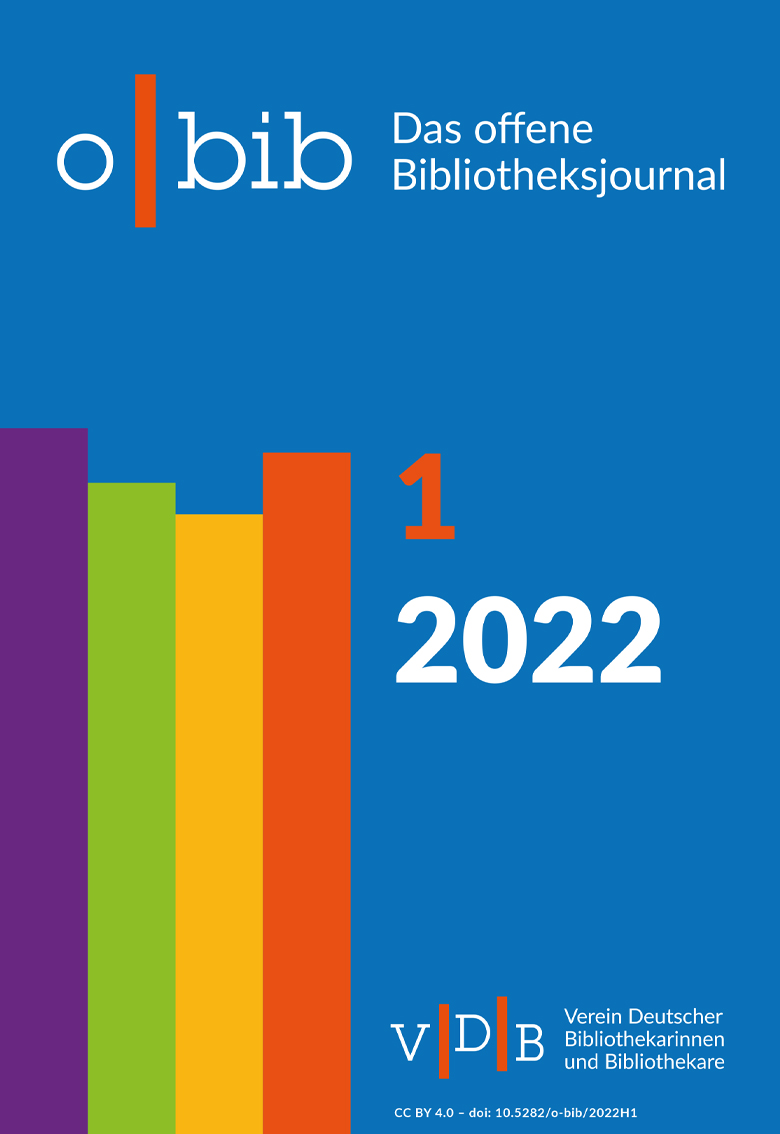Open Access an Hochschulen für angewandte Wissenschaften und Pädagogischen Hochschulen in Baden-Württemberg
Eine empirische Erhebung der Bedarfe, Hemmnisse und Wünsche bei Bibliotheken und Forschenden
DOI:
https://doi.org/10.5282/o-bib/5793Keywords:
Open Access, Universities of Applied Sciences, Universities of Education, Baden-Wuerttemberg, Empirical analysisAbstract
Introduction: The open access publishing behaviour and the required open access services at universities of applied sciences (HAWs) and universities of education (PHs) have not been studied so far. The e-science strategy of Baden-Wuerttemberg aims, among other things, at digitization, open access and research data management to increase the quality and competitiveness of science. Based on comprehensive empirical surveys, the specific needs, barriers and requests of HAWs and PHs are identified. Thus, the services required for the characteristic open access publishing at HAWs and PHs can be identified, dependent on requirements, in order to promote the visibility and competitiveness of research.
Methods: Comprehensive empirical surveys were collected in 2020 using a mixed-methods approach. In addition to 19 explorative digital guideline interviews with members of universities and institutes, a questionnaire was created for the survey of all 47 library heads of universities in Baden-Württemberg on the basis of these interviews as well as surveys and exchanges within the open access community. In addition, researchers at eight selected HAWs and PHs in Baden-Württemberg were surveyed online using a second questionnaire. The aim was to ascertain the barriers, needs and requests of the HAWs and PHs in Baden-Württemberg.
Results: 34 library heads (72 %) and 563 researchers participated in the surveys. The library head survey indicates that three HAWs and one PH have an open access officer, and 12 HAWs (of all 16 HAWs) and 5 PHs (of all 6 PHs) operate a repository. Researchers and library heads indicate that funding for open access publishing costs at HAWs is primarily through external funding (69 %) and at PHs through a federal state fund (83 %).
Since 2017, most researchers at HAWs (71 %) and PHs (77 %) have been engaged in scholarly publishing. A conscious decision for publishing open access is important to half of the re searchers (49 % HAW, 48 % PH), whereas 7 % and 4 % respectively prefer a specific journal, regardless of open access. 39 % and 49 %, respectively, were aware of publishing open access. The level of knowledge of the library heads is very heterogeneous and there are many topics which they could not answer at all or not adequately. Inquiries from researchers mostly refer to the topic of funding (58 %, 59 %). The majority of researchers are not aware of the option to publish in institutional (69 %, 60 %) or subject repositories (77 %, 72 %) or of DEAL contracts (78 %, 90 %). Researchers see many benefits of open access, yet have also concerns about fake journals and funding. Researchers would like to see publication costs covered (70 %, 69 %), a contact person at the university (60 %, 74 %), and information on the university website (56 %, 72 %).
Discussion: Members of PHs and HAWs are actively doing research and publish their results. However, the infrastructural requirements for supporting and advising researchers with regard to open access publications have not grown in parallel. The actively expressed need for adequate support and information cannot be met due to low staffing levels. There is a need to support researchers, but above all to strengthen the competencies and information for libraries so that they can advise researchers in a needs-oriented manner.
Conclusion: Targeted addressing of HAWs and PHs based on the empirical surveys is necessary to support the open access transformation and thus to continue to ensure the quality and competitiveness of research at HAWs and PHs in the future. Open access publication support is a broad field of activity and diverse, up-to-date, and high-quality materials are needed at each university. Due to the low staffing levels, it is recommended that competencies be pooled across universities for synergy effects.
References
Halbherr, Verena; Reimer, Nadine; Paichard, Marine u.a.: Open Access an Hochschulen für Angewandte Wissenschaften und Pädagogischen Hochschulen in Baden-Württemberg: Potentiale und Defizite, zenodo, 24.09.2021, https://doi.org/10.5281/zenodo.5526742.
Heise, Christian: Von Open Access zu Open Science. Zum Wandel digitaler Kulturen der wissenschaftlichen Kommunikation, 2017, https://pub-data.leuphana.de/frontdoor/deliver/index/docId/841/file/final_druck_diss_heise_de_en_2017_61217.pdf, Stand: 04.12.2021
Pampel, Heinz: Open Access an wissenschaftlichen Einrichtungen in Deutschland. Ergebnisse einer Erhebung im Jahr 2018, 2018, https://gfzpublic.gfz-potsdam.de/rest/items/item_4550890_6/component/file_4570895/content, Stand: 04.12.2021.
Reimer, Nadine; Halbherr, Verena; Ackermann, Sebastian u.a.: Ein Projekt zur Implementierung von Open Access an den Hochschulen für angewandte Wissenschaften (HAW) und den Pädagogischen Hochschulen (PH) in Baden-Württemberg, zenodo, 24.09.2020, https://doi.org/10.5281/zenodo.4035970.
Downloads
Published
Issue
Section
License
Copyright (c) 2022 Verena Halbherr, Nadine Reimer

This work is licensed under a Creative Commons Attribution 4.0 International License.





